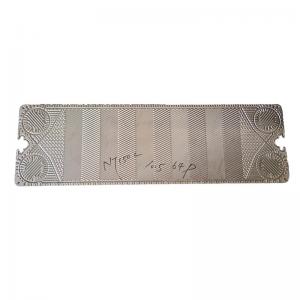Product Details
Product Description
SS316 SS304 Titanium GEA Heat Exchanger Plates Hastelloy C276 For
Gasket Plate Heat Exchanger
GEA Heat Exchanger Plates
- The plates are equipped with sealing gaskets to seal the fluid
channels and guide the fluids to alternately flow into their
respective flow channels to form heat exchange. The flow rate,
physical properties, pressure drop and temperature difference of
the fluid determine the number and size of the plates.
- The corrugated plate not only increases the degree of turbulence,
but also forms many support points, which are enough to withstand
the pressure difference between the media. The metal plate and
movable plate pressing plate are suspended from the upper guide rod
and positioned by the lower guide rod, while the rod end is fixed
on the support column.
Various models have deep corrugations, shallow corrugations, large
angles, small angles, etc. to ensure that they meet the needs of
different users. Special working conditions can be specially
designed and manufactured according to user needs.
| Brand | Model |
GEA | VT04,VT10,VT20,VT40,VT80,VT405,VT2508,N40,FA184,NT50,NT100T,NT100M NT100X,NT150S,NT150L,NT250S,NT250M,NT250L,NT350S, NT350M,NT500 |
| Material | Specification |
| Stainless Steel | SUS304 316 316L 310S 904 |
| Titanium and titanium-palladium alloy | TAi TAi-Pd |
| Hastelloy | C276 D205 B2G |
| Nickel | Ni200 Ni201 |
| Molybdenum | 254 |
Applacations
| Plate material | Suitable for fluids |
| Stainless steel (SUS304.316, etc.) | Purified water, river water, edible oil, mineral oil |
| Titanium and titanium palladium (Ti, Ti-Pd) | Sea water, salt water, salt compounds |
| 20Cr,18Ni,6Mo(254SMO) | Dilute sulfuric acid, dilute salt aqueous solution, inorganic
aqueous solution |
| Nickel (Ni) | High temperature, high concentration caustic soda |
| HASTELLOY alloy (C276, D205, B2G) | Concentrated sulfuric acid, hydrochloric acid, phosphoric acid |
Heat exchanger plate Choose:
- The choice of plate types and corrugation patterns for heat
exchangers plate should be based on the specific heat transfer conditions and
requirements. In situations where there is a large flow rate and a
small allowable pressure drop, plates with low resistance should be
selected. The selection of removable or brazed plate heat
exchangers should be determined based on the pressure and
temperature conditions of the heat transfer medium.
- For equipment with a large heat transfer area, it is not advisable
to choose plates with excessively small individual plate areas.
This is because having too many plates may result in low flow
velocity between the plates, leading to a decrease in the overall
heat transfer coefficient.
Production Process:
The production of stainless steel plates for plate heat exchangers
involves several precise steps to ensure high-quality performance
and longevity.
- Cutting and Leveling: Stainless steel plates are accurately cut
using advanced machine tools to meet the specific design
requirements. After cutting, a leveling treatment is applied to
ensure a smooth and even surface. This step is crucial for
maintaining efficient heat transfer capabilities.
- Stamping: The flattened plates undergo a meticulous stamping
process using hydraulic presses. This process creates unique
herringbone patterns on the plates, which significantly increase
turbulence inside the heat exchanger. The controlled turbulence
promotes optimal heat transfer by maximizing fluid contact with the
plate surfaces. Special attention is given to maintaining precise
control during stamping to prevent plate deformation or damage.
- Surface Treatment: To enhance corrosion resistance and optimize
heat transfer performance, the plates undergo surface treatments
such as polishing, sandblasting, or coating. The specific treatment
method is selected based on the desired requirements and operating
conditions. These treatments improve the plates' resistance to
corrosion, fouling, and scaling, ensuring long-term efficiency and
reliability.
Company Profile
Jiangsu Victory Co., Ltd. is a professional manufacturer of plate
heat exchangers (PHE), heat exchanger gaskets (PHE GASKET), and
heat exchanger plates (PHE PLATE).
Our company has introduced advanced design and production
technology as well as advanced heat exchanger expertise at home and
abroad, and has been committed to serving the HVAC, refrigeration,
energy and power, metallurgy, chemical industry, pharmaceutical,
food, electronics, shipbuilding and environmental treatment
markets. , providing on-demand heat exchange solutions and
all-round services. Friends are welcome to visit, guide and
negotiate business.
At the same time, we are also a professional supplier and
maintainer in the field of plate heat exchanger accessories (heat
exchanger plates and heat exchanger gaskets). Able to provide the
same products as many well-known brands at home and abroad
(including: Alfa, ACCESSEN, GEA, TRANTER, SONDEX, FUNKE, Vicarb,
etc.) Plate heat exchanger plates and gaskets in specified sizes.
No matter where you are, no matter what your special requirements
are, Victory is willing to provide you with system solutions in the
field of plate heat exchangers.




